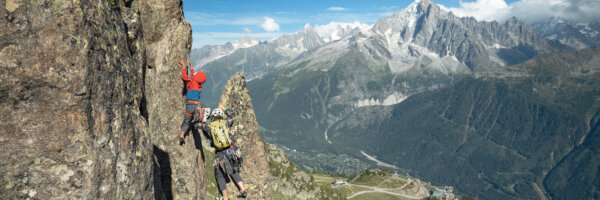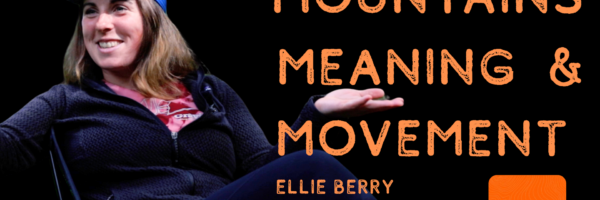Words by Jamie Ball
Why bother your arse with an Ironman?

Seriously. It’s not like there isn’t enough selection of tri (triathlon) events in Ireland between late spring and early autumn each year. Hosted by Triathlon Ireland, they range right up to standard (i.e. Olympic) distance events (i.e. 1.5km swim, 40km cycle, 10km run) and sometimes beyond.
Why, then, did I bother? Well, I guess I felt somewhat at a crossroads. I’d knocked off several standard distance tris in recent seasons and was ready to bite off a little more. It was never part of the original plan when taking up triathlon, which originally was to complete a single standard tri.
But being in the positive, pragmatic and supportive peer group of Portmarnock Tri Club, the plan simply evolved a few seasons in, as I got fitter. Besides, it’s good to push your boundaries … within reason, bearing in mind that what is one man’s reason, is another’s lunacy.
2023 is when the bug kicked in. I signed up for the Cork Half-Ironman (the awkwardly title ’70.3’, from the number of miles covered in the event, since it originated in the States). That consists of a 1.9km swim, 90km cycle and 21km run, which I completed and largely enjoyed. Or at least until getting across the finishing line, to learn that two fellow competitors had died during the particularly rough swimming conditions. It left a sad and sour taste in the mouth.
Consequently, it – the only remaining Ironman event in Ireland – was consequently cancelled for 2024 (and, incidentally, also for 2025), yet I returned to the well by booking my sorry soul in for the Cascais half-ironman last October.
October Calling
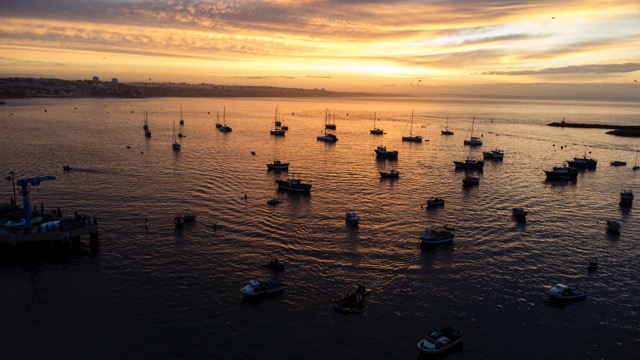
A popular spot for discerning Irish holidaymakers, Cascais is a stately, picturesque coastal resort less than 45 minutes from Lisbon, with roots reaching back to the 12th Century. It was reborn as a high-class seaside resort in the 1800s, when the Portuguese Royal family and hobnob nobility established their summer residences there to escape the stifling heat of Lisbon.
The Cascais Ironman each October seems to be a favourite for Irish and British triathletes, and I could soon see why.
The place is gorgeous; historic and refined, it is also very well equipped for any triathlon event, offering a lovely, semi-sheltered bay, seaside and hilltop cycling routes, and a gently lumpy running course on the Atlantic edge. It attracts thousands of entrants from mostly across Europe each year, and the locals seem genuinely up for the event – out cheering and waving and drum-banging.
Yet I reckon the timing is also much of the draw. October is just a good month for an Irish triathlete to target an Ironman ‘on the continent.’ Firstly, it gives you a feasible target for the kind rub of summer training – no matter the rain or wind of an Irish summer, at least there is plenty of daylight and ‘trainable’ temperatures.
But October on the ‘Portuguese Riveria’ is most equitable for such endurance events, following months of training in the Irish climate. The temperature hovered around 20° degrees Celsius beneath a thin film of high cloud, with the water at about 18° (i.e. warmer than the average summer temperatures of the Irish Sea).
As for cost, it will set you back about €480 for a single/general entry, or €639 for the relay. So, it’s not cheap, but weigh that up against the scale of organisation and resources needed to successfully pull off such an event (the road closures, alone, to facilitate the running and cycling routes), and to be fair, Ironmen events are excellently organised.
THE BUZZ, THE BUILD UP & THE BRANDING
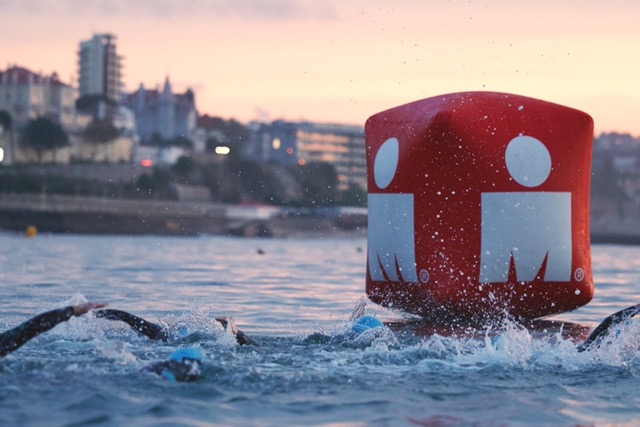
The buzz builds from Wednesday, but I found it fine to arrive on Thursday lunchtime, in preparation for the Saturday showdown.
Don’t underestimate the time it will take to ensure that All-Things-Bicycle are in order. Whether you’re hiring one (see below) or else bringing your own bike over in a bike case, it takes time to assemble, check and ensure fittings, tyres etc. are race worthy.
Remember you have to register, and then there are helpful briefings you can attend, which set out the course in more detail than in the entrant PDF Guide. Then there is also the bike check-in (into the transition area, for after your swim) the day before to factor in; not as straightforward as you might imagine, considering there are thousands of others aiming to do likewise. So make sure you arrive at least two days before your event.
The Thursday evening sees the relatively low energy opening ceremony fizz out like a warm beer. And there lies the snag, for me. Ironmen/women tend not to be all too sociable and, as a sweeping overview, far too many take themselves far too seriously. Come on! Most are like me: middle aged amateurs, winging it. So try lightening up a little.
The only other turn-off about Ironman is how demonstrably, unapologetically commercially cut-throat it all is. As if parting with the best part of €500 wasn’t enough, from the moment you arrive at an Ironman it’s all about the upsell – Merch! Merch! Merch! – and all the time, visually and aurally – mercilessly ramming the brand down your throat.
THE SWIM & CYCLE
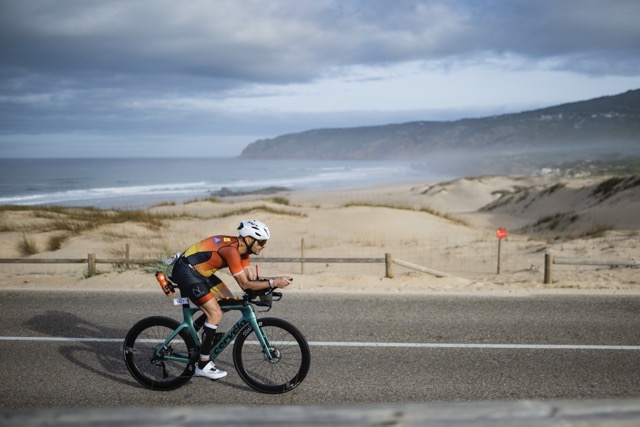
But am I being a little petty? What matters most is the event itself, and that wasn’t found wanting to any degree.
I rose around 4.45am and fed on a feast of porridge and carbs in the hotel dining room, before taking one of multiple shuttle busses to the event – a 10 minute ride, at most. The swim warm-up was performed under a glorious, fading moon, then watched the sun come up over Ribeira Beach less than an hour later, as a crowd of thousands gathered to sing the Portuguese National Anthem. Then, we were off.
It’s a rolling start, with six starting boxes (i.e. pens). Each box indicates which completion time for the swim you’re likely to make, be it more than 20, 25, 30, 35, 40, 45 or 60 minutes (the swim cut-off time is 70 minutes).
The 1.9km swim was lovely; fractionally warmer than what I’d trained in all summer and with a most gentle of swells. I soon got into my stride, relaxed the breathing and just concentrated on my stroke technique: a great form of Mindfulness, I find, that refocuses thoughts away from the mighty task ahead, to focus on each and every stroke.
In no time it seemed, I was out and plodding through transition and soon on my bike. The bike course is a cracker and so well waymarked; you’d have found your way even if you were blindfolded.
The 90km course skirts along the rugged Atlantic Coastline for the first half hour or so, and then inland up the hills, with about 700m total elevation through the cycle. The roads are closed off for the event, so you never have to worry about traffic, and there’s a cut off time of five hours, 30 minutes for the cycle.
There are heaps of well stocked food & drink stations throughout the bike and run course, so you really have to carry very little with you, in that regard. When descending from the hills, we’re diverted into the Lisbon Grand Prix track, and the surreal touch went down well – bizarrely, the Grand Prix circuit was the most sedate, peaceful locale across the whole day.
The final 55/60km of the cycle is effectively following the harbour road as it leads into the centre of Lisbon, and back to Cascais. It’s an undulating stretch across a fine surface, but the energy out there is magic, with all the local well-wishers urging us on, and with a slight coastal breeze keeping it cool.
THE RUN & THE RETROSPECT

The run is 21km in total, and is lumpy in nature – roughly 180m elevation, in total – but all very gently inclined. It’s two laps of the same ‘out and back’ course, with seven food/drink/aid stations on each route, and commanding views out over the Atlantic.
Well in advance of the event, I realised I’d have little left for the run, even if I did hold back a little on the cycle, so I went all out and largely emptied the tank by the time I got off the bike. Not the best of tactics, but, then again, I don’t claim to be the best of athletes.
I was largely running on empty, but I just kept trudging along, feeding off the goodwill and animation of the supporters, along with the sea views, while dumping endless fathoms of water over my head, to keep from overheating. Yes, it was tough, but truth be told, once I started my slow-trudging jog, I was never in doubt about finishing.
Each time I was even tempted to feel sorry for myself I’d remind myself that I chose to be here and how lucky I was to have the good health to be part of such an event.
Overall, was it worth doing? Most certainly. Will I ever do an Ironman again? Probably not.
The event itself really is the best part of it all, but it’s the hours and hours of endless training over the previous 2-3 months that utterly drained any glimmer of hope in maintaining a tolerable work-life balance. And if I don’t do another it’s also because there are just too many other activities/ events out there, across all sorts of disciplines, that my ceaseless curiosity calls out to.
On balance, would I recommend the Cascais 70.1? Absolutely.
Bike hire

I chose to rent a bike there through Cycling-Rentals (https://www.cycling-rentals.com/ ). I went with a very standard, simple road bike, and had emailed my height through in advance, and found it was well fitted. It came in about €210 for the hire. They delivered the bike to my hotel two days before the event, to be left in my hotel room the day following the event.
Make a holiday of it
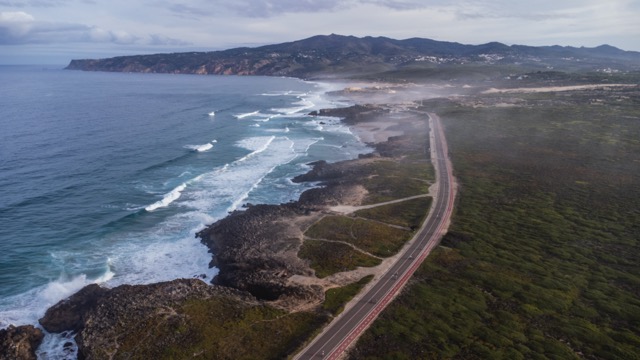
Cascais is so very accessible – just a 30-45 minute drive from the Lisbon airport. When not prepping for all things Ironman, be sure to get out and smell the roses – why not make a short holiday of it, and stay on for a good 2-3 days after the event?
A hire car is probably your best bet to get around, so a must is to travel the half-hour or so to Monserrate Palace. While it may thronged with tourists like you, have a good look and walk about Sintra town, and then spend some of the afternoon in the Pena National Palace.
Back in Cascais, the Casa de Santa Maria is a grand 19th century stately home that has a prime coastline location; constructed by an Irish millionaire who made his fortune in the tobacco industry.
It’s worth also taking a wander down to the Cascais lighthouse museum “Farol de Santa Marta,” which opened to the public in 2007, with the exhibition spaces doubling up with the operational functions of the lighthouse. And if you’ve got the legs, then journey on down to the Boca do Inferno (Hell’s Mouth) viewpoint – one of the more striking viewpoints located along the rocky shoreline.
For more information on all there is to do and see in Cascais and wider surrounds, visit www.visitcascais.com.
Accommodation:
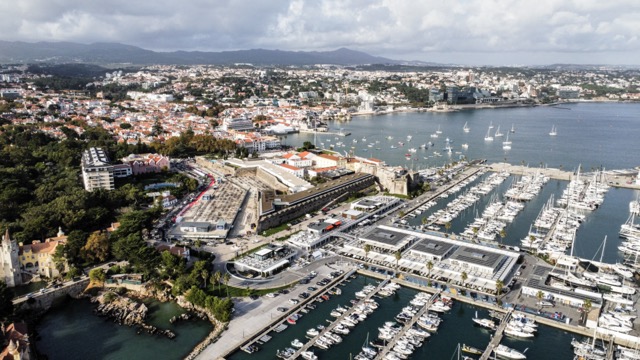
I stayed in the official Ironman Hotel for the event, the wonderful Quinta da Marinha Hotel. All staff are fully geared up to cater for the athletes with an Ironman information desk by the lobby and a nearly round the clock bike mechanic in the basement. Then there’s the ‘pasta party’ feast the night before the event, and a special high-energy early breakfast (from 4.30am) on the morning of the event.
The hotel is about 5km out from the town centre, but there are endless (free of charge) shuttle buses running to and from, and not just on the Big Day. Being in a more spacious, peaceful and verdant suburb, it’s a great place to declutter from all the high energy buzz and clamour in the lead up to the event. Ironman package at the hotel prices start from €253.
Flights:

Jamie travelled Dublin-Lisbon return, courtesy of Aer Lingus. Aer Lingus operates 6 flights per week between Dublin and Lisbon. One-way fares start from €49.99, including taxes and charges for travel before the end of April. For more information on fares and schedules and to book visit www.aerlingus.com.
Jamie Ball was a fully supported guest of Visit Cascais (www.visitcascais.com) and Ironman Cascais (www.ironman.com/races/im-cascais)
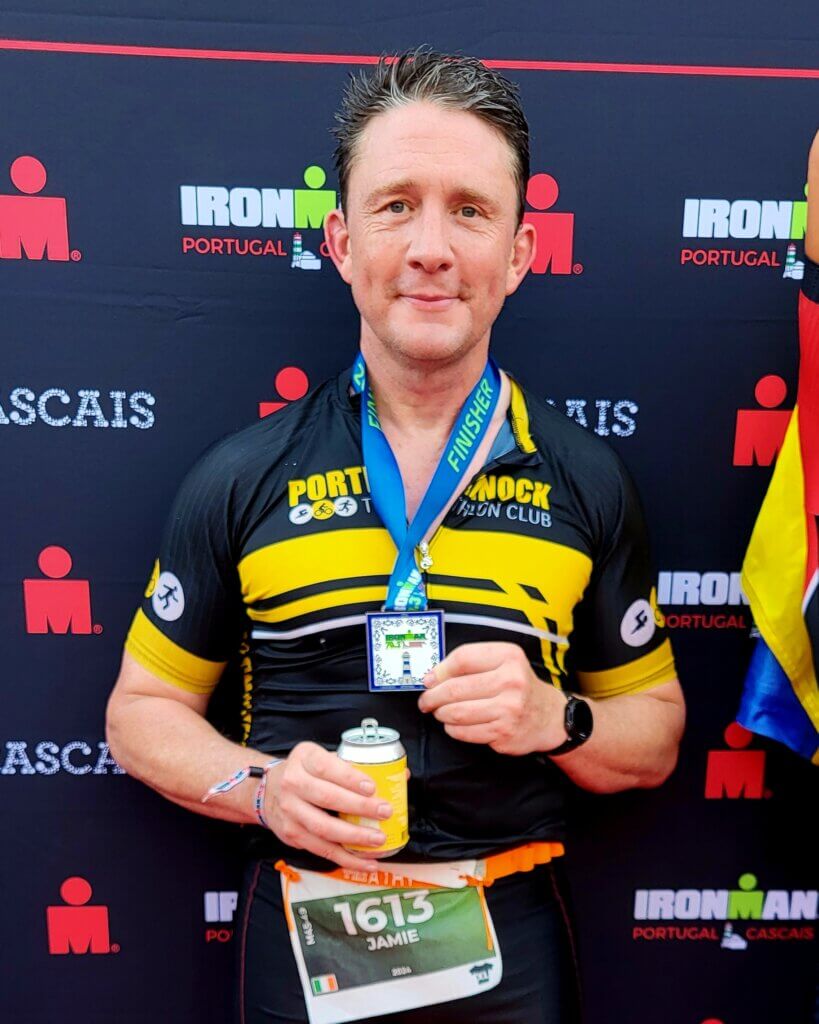
Recommended for you:
Meet the man doing an Ironman a week for 52 weeks
The Ultimate Guide to the Blacksod Triathlon
10 Of The Best Triathlon Wetsuits for any Budget



